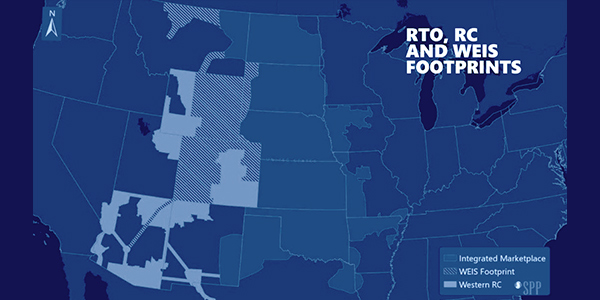Last year began with a foreshadowing of the twists and turns to come for SPP when its Board of Directors appointed Barbara Sugg as CEO in January.
In a traditionally male-dominated industry, Sugg joins the Australian Energy Market Operator’s Audrey Zibelman as the only women in the world running an electricity marketplace.
In choosing Sugg from a pool of candidates that included several with a “broader set of CEO experience,” the directors cited Sugg’s ability to develop, build and strengthen relationships as being “increasingly critical” to SPP’s success. (See SPP Board Taps Barbara Sugg as New CEO.)
Sugg wasted little time in dethawing SPP’s frosty relationship with MISO in recent years. Shortly after officially becoming CEO on April 1, she contacted MISO’s John Bear and opened a line of communication. The two have bonded over their love of white Labradors — each owns one — and have appeared together in several virtual settings this year, exchanging kudos and acknowledging each other’s willingness to work together.
“I really appreciate you reaching out quickly when you took your new role,” Bear told Sugg in December.
Sugg told RTO Insider it was simply a matter of following new corporate goals that include improving the MISO relationship “for the benefit of both regions.”
“I eagerly accepted responsibility for this goal and gave it a high priority,” she said, noting MISO’s “warm reception” and its commitment to also work on the relationship.
“It is only through a healthy mutual relationship that we will successfully tackle the many challenges faced along our seam with MISO,” she said.
After four joint studies over the previous six years failed to produce a single interregional transmission project, the RTOs are embarking on a year-long study in 2021 to identify and fund projects that can resolve congestion along their seam. They say the transmission system is at capacity in the upper Midwest, but that current mechanisms do not provide enough cost sharing to encourage new generator interconnections. (See MISO, SPP Stakeholders Applaud New Joint Study.)
Hopes are high on both sides that the study will produce results as developers continue to propose new projects that put further strain on the system. The interconnection queue has 39.9 GW of wind projects and 36.3 GW of solar facilities under some form of study, with even energy storage (8.9 GW) outpacing natural gas (5.0 GW).
Wind energy was already on track to overtake coal as SPP’s No. 1 fuel source in early December. Wind makes up about 27% of capacity, but has averaged 31% of the fuel mix, ahead of coal (30.3 %) and natural gas (27.2%).
Twice in December SPP set new records for wind and renewable energy peaks, settling at 19.7 GW and 20.9 GW, respectively, on Dec. 23. Wind has accounted for as much as 75% of the RTO’s production at one time.
Western Interest
SPP’s ample renewable resources are one reason several Western utilities have indicated a desire to join the RTO’s expansion into the Western Interconnection. The grid operator launched reliability coordination services in the West in 2019, and its contract-based Western Energy Imbalance Service (WEIS) market is scheduled to go live in February.
WEIS participants Basin Electric Power Cooperative, Deseret Power Electric Cooperative, the Municipal Energy Agency of Nebraska, Tri-State Generation and Transmission Association, and the Western Area Power Administration have all expressed an interest in placing their Western Interconnection facilities under SPP’s Tariff. (See Western Utilities Eye RTO Membership in SPP.)
Tri-State CEO Duane Highley said that if the cooperative is to successfully integrate renewables and meet clean energy targets, it will have to participate in an RTO in the West.
“One of the great attributes of SPP is its reach across 14, 15 states. [It’s] been able to integrate more renewables in a bigger way than thought possible,” Highley said.
Sugg told stakeholders in a year-end email that SPP has other “big things in the works” for 2021. In addition to the WEIS market and reorganization of the Markets and Operations Policy Committee’s stakeholder groups, she listed the Strategic and Creative Re-Engineering of Integrated Planning Team’s (SCRIPT) work revamping transmission planning processes and a new five-year strategic plan that clearly defines the RTO’s mission, vision and shared objectives.
“And that’s just scratching the surface,” she said.
Character Revealed
Sugg nears the end of her first year as CEO the same way it began — working from home in the midst of the COVID-19 pandemic.
By the time she officially took on the role in April, non-control room staff were working remotely, employee travel was prohibited and all stakeholder meetings were virtual. She had expected “the most challenging and rewarding assignment of my career,” but this?
“I had no idea,” she told stakeholders. “More than nine months later, I have yet to see my first ‘normal’ day.”
It will be several months yet. SPP said staff won’t return to the office until April at the earliest.
“Crises don’t build character, they reveal it,” she told stakeholders. “This year has revealed the strength of character of the amazing staff I have the honor to lead at SPP. It’s also shown me the character of all of you working on behalf of our region to keep the lights on today and in the future. Working together, we have accomplished incredible things in the face of substantial opposition.”




